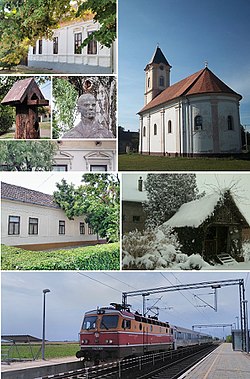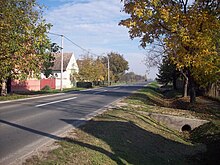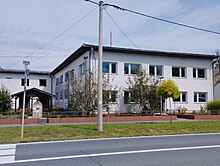Banovci, Vukovar-Syrmia County
Banovci
| |
|---|---|
Village | |
 | |
 | |
| Country | |
| County | |
| Municipality | Nijemci |
| Population (2011)[2] | |
| • Total | 432 |
| Time zone | UTC+1 (CET) |
| • Summer (DST) | UTC+2 (CEST) |
| Postal code | 32247 Banovci |
Banovci (German: Schider Banovci,[3] Serbian Cyrillic: Бановци[4]) is a village in eastern Croatia, near the Serbian border. It is connected to surrounding areas by the D46 highway and Zagreb-Belgrade Railway. The village is 116 km away from Belgrade (Serbia), 158 km from Sarajevo (Bosnia), 249 km from Zagreb (Croatia) and 257 km from Budapest (Hungary).

History and Name
The village of Banovci was called "Novi Banovci" up until the year 1900 and "Šidski Banovci" between 1910 and 1991,[5] with many local residents continuing to use the latter title. The first word in the post-1910 name is a possessive adjective derived from the name of the nearest town, Šid, located 12 kilometers from Banovci in neighboring Serbia. Similarly titled, Vinkovački Banovci is the name of the village adjacent to Banovci. Croatian Railways, the national railway company, still uses the name Šidski Banovci for the local railway station to distinguish it from the village of the same name (Banovci) in Brod-Posavina County.[6]
Languages
Due to the local minority population, the Nijemci municipality allows the use of not only Croatian as the official language, but the Serbian language and Serbian Cyrillic alphabet as well in Banovci.[7][8]
Society
The village is home to approximately 500 people and most have declared themselves Orthodox Christians and Serbs.
The population of Banovci derives most of its income from agriculture; however, unemployment is high due to war and ethnic struggles.[citation needed]
| Population[9] | |||||||||||||||
|---|---|---|---|---|---|---|---|---|---|---|---|---|---|---|---|
| 1857 | 1869 | 1880 | 1890 | 1900 | 1910 | 1921 | 1931 | 1948 | 1953 | 1961 | 1971 | 1981 | 1991 | 2001 | 2011 |
| 460 | 779 | 651 | 836 | 890 | 990 | 1047 | 1139 | 1028 | 1138 | 1084 | 975 | 778 | 653 | 479 | 438 |
Slobodan Bajić Paja, a People's Hero of Yugoslavia, was born in Banovci and is best known for his participation in the resistance that fought against the Nazi forces in World War II.
German community
Before World War II Banovci was mostly populated by Germans. According to the census of 1910, Banovci had 990 residents, 668 of whom were Germans. They had developed a social life and a multitude of public institutions. The most important was the local Protestant church. Next door to the church was the school, which served as the city hall, and a bank was nearby. Local residents cherished traditional values; it was a village that maintained a strong work ethic. In late 1944 villagers had just barely escaped from Banovci. This was similar to that experienced by thousands of other ethnic Germans in the latter stages of World War II. The new post-war government declared that ethnic Germans in Yugoslavia were no longer citizens and confiscated their property. By 1945, nearly 500,000 Germans had been expelled—the term that would be used in Article XIII of the Potsdam Agreement was "transfer" from Yugoslavian territory. The residents of Banovci had some advance warning from the German Army that they would have to leave their homes and evacuate the village. On October 17, with the Banovci church-bells pealing, a caravan of 40 to 50 families formed and proceeded out of the village and into the uncertain terrain ahead. They headed northwest toward Hungary.[note 1]
Religion
Serbian Orthodoxy

The neoclassical St. Petka's Church was built between 1773 and 1777. The church and its parish are under jurisdiction of Eparchy of Srem which is based in Sremski Karlovci in neighbouring Serbia. The church is dedicated to Saint Parascheva of the Balkans.
Pentecostalism
First Pentecostal activities in Banovci started in 1920.[10] For beginning of activities of this religious group is connected story about miracle cures of local girl Elizabeth Spies.[10]
Calvinism
Evangelical Lutheranism
Culture
Every year on the Orthodox Christmas Eve (January 6), residents in the churchyard have a bonfire for "Badnjak", the Serbian word for Christmas Eve. In this occasion locals take oak trees from the area and make a ritual fire. These nights the locals remember their old Slavic religion and symbolically confirm Christianity.
In the rest of the year, villagers are organized around the celebration of New Year's, Women's Day, labor day, the occasion of the end of the school year, important religious holidays, etc. The football club, pensioners club, the Protestant community and the Women's Caucus, which also periodically organizes public events, are active participants.[note 2]
Education

Elementary School Ilača-Banovci (Croatian: Osnovna škola Ilača-Banovci is an elementary school situated in Ilača, Banovci and Vinkovački Banovci. Classes are taught in Croatian and Serbian.

The Banovci School used to host the center of the school administration, before it was moved to Ilača in 2002.[11] Classes in Banovci are conducted in the Serbian version of the Serbo-Croatian language. The school is located in the center of Banovci. The school contains a small gym, garden and football field.[note 3]
In addition to classes at the other two schools, students in Banovci must also take Serbian Language, Orthodox Religion Education, History of Serbia, Geography of Serbia and Arts and Music of Serbia.
The school organizes several annual celebrations that involve the entire local community (at the start of school year, Bread day, Sport day, St. Sava, and at the end of school year).
Sport
NK Borac is a football club based in the Banovci. The club was founded in 1940 by a group of local football fans. The name of the club means "Fighter", referring to local soldiers from the World War II. The club owns the local playground in Banovci. The club regularly achieves good results in the 3 County League and is usually among the top three clubs. NK Borac is funded by donations from local community, the municipality and local businesses. Borac footballers are volunteers and do not receive financial compensation.
In addition to their regular activities, NK Borac Banovci has developed a collaboration with local schools with the project Sport Day. The Sport Day is an event that is held every spring. The students are released from classes to be on the Borac court competing in various sports activities such as football, racing and old sports. To further engage youth and initiate them into the mad football rage of Europe, Borac also launched the youth football club.
See also
Notable natives and residents
Notes
- ^ The Huber family (Wilhelm Huber was born in 1824 and became the first Huber to settle in Banovci), in the book The Past Rebuilt: The Huber Family Journey to Success, describes their travails during this time.
- ^ It is interesting that Banovci are one of the last places in Croatia that has retained its street names from the period of communist Yugoslavia. This was done at the express request of the villagers. For this reason, the name of the main street still bears the name of former Yugoslav President Josip Broz Tito, while other streets are named by prominent members of the anti-fascist movement during World War II.
- ^ Before the war there was also a large hall which has not yet been restored.
References
- ^ "PETO IZVJEŠĆE REPUBLIKE HRVATSKE O PRIMJENI EUROPSKE POVELJE O REGIONALNIM ILI MANJINSKIM JEZICIMA, page 35" (PDF). Retrieved 31 May 2015.
- ^ "Population by Age and Sex, by Settlements, 2011 Census: Municipality of Nijemci". Census of Population, Households and Dwellings 2011. Zagreb: Croatian Bureau of Statistics. December 2012.
- ^ "Syrmia Village Index". Retrieved 7 February 2016.
- ^ "Registar Geografskih Imena Nacionalnih Manjina Republike Hrvatske" (PDF). Archived from the original (PDF) on October 29, 2013. Retrieved 2013-03-08.
{{cite web}}: Unknown parameter|deadurl=ignored (|url-status=suggested) (help) - ^ http://www.dzs.hr/hrv/pxweb2003/Dialog/Footnote.asp?File=Tabela4_16.px&path=../Database/Naselja%20i%20stanovnistvo%20Republike%20Hrvatske/4%20Stanovnistvo%20naselja/&ti=Vukovarsko-srijemska+%9Eupanija+-+broj+stanovnika+po+naseljima+&lang=10&ansi=1
- ^ http://vred.hznet.hr/hzinfo/?category=hzinfo&service=vred3&nkod1=ZAGREB GL. KOL.&nkdo1=ŠIDSKI BANOVCI&lang=hr&screen=4
- ^ Izvješće o provođenju ustavnog zakona o pravima nacionalnih manjina i o utošku sredstava osiguranih u državnom proračunu Republike Hrvatske za 2008. godinu za potrebe nacionalnih manjina, Zagreb, 2009.
- ^ "Archived copy" (PDF). Archived from the original (PDF) on October 29, 2013. Retrieved March 8, 2013.
{{cite web}}: Unknown parameter|deadurl=ignored (|url-status=suggested) (help)CS1 maint: archived copy as title (link) - ^ - Republika Hrvatska - Državni zavod za statistiku: Naselja i stanovništvo Republike Hrvatske 1857.-2001.[full citation needed]
- ^ a b Kovačević, David (June 2013). "Prikaz razvoja Crkve Božje u Banovcima". Kairos: Evanđeoski teološki časopis (in Croatian). VII (1.). Osijek. Retrieved 2013-07-12.
- ^ "Odluka o promjeni sjedišta Osnovne škole Ilača-Banovci" (PDF). Službeni vjesnik. Vukovar-Srijem County. 2002-05-02. Archived from the original (PDF) on 22 July 2011. Retrieved 2011-06-09.
{{cite web}}: Unknown parameter|deadurl=ignored (|url-status=suggested) (help)

